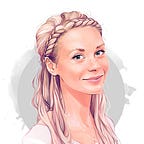Case #4 Group surety lending
(Cases of How Humaniq can be used in the future)
In 1974, during the infamous Bangladeshi famine, Muhammad Yunus gave 42 farmers a small loan of $27 each under friendly lending terms. In most cases, this appeared to be enough to open a small business. Talking to people, Yunus figured out that most of them need rather small amounts of money to kick off a small enterprise.
This convinced him that this lending practice might diminish the poverty in other rural areas of Bangladesh. Yunus began to expand his microcredit research project to test his method for providing credit and banking services to the rural poor, eventually founding Grameen Bank (literally rural bank) in 1976. Proving successful, with support from the central bank of Bangladesh, the bank was expanded in 1979 to the north of the capital city of Dhaka, and later — to other districts of Bangladesh.
By 2006, Grameen Bank branches numbered more than 2,100 and its success has inspired similar projects in more than 40 countries around the world, including a World Bank initiative to finance Grameen-type projects. The bank claims a loan recovery rate of 96.67 per cent. The Bank incorporates the set of values known as 16 Decisions. These Decisions include water purification, educating children, building and using latrines. At every branch of Grameen Bank, the borrowers recite these Decisions and vow to follow them. The bank is founded on the belief that people have endless potential, and unleashing their creativity and initiative helps them end poverty. The primary goal of Grameen is to provide money to help talented people produce things. Grameen has provided credit to classes of people formerly underserved: the poor, women, undereducated, and unemployed people. Access to credit is based on reasonable terms, such as the group lending system (one person lends, four act as collateral backers) and weekly installment payments, with reasonably long terms of loans, enabling the poor to build on their existing skills to earn better income in each cycle of loans. The interest rates charged by microfinance institutes including Grameen Bank are high compared to that of traditional banks; Grameen’s interest on its main credit product is about 20%.
As of January 2011, the total borrowers of the bank numbered 8.4 million, and 97 per cent of those are women. As of October 2007, the Bank had a staffof more than 24,703 employees and its 2,468 branches provided services to 80,257 villages. The bank has distributed Tk 684.13 billion ($11.35 billion) in loans, out of which Tk 610.81 billion ($10.11 billion) has been repaid. The bank claims a loan recovery rate of 96.67%. It is claimed that 50 million people have risen out of acute poverty. Give it a think. Credit organizations, lending money to poorest of the poor, encouraging them to unleash their talents and accept the new values, the life-changing 16 Decisions. Some 8.4 million borrowers with a return rate of 96.67 per cent and $11.35 billion US dollars lended. Now that deserves a Nobel Prize and that’s why they got one. Let us show you the brief overview of differences between Grameen Bank and Humaniq:
On December 10, 2006, Mosammat Taslima Begum, who used her first 16-euro (20-dollar) loan from the bank in 1992 to buy a goat and subsequently became a successful entrepreneur and one of the elected board members of the bank, accepted the Nobel Prize on behalf of Grameen Bank’s investors and borrowers at the prize ceremony held at Oslo City Hall. That indicates the tremendous success that Grameen Bank and its branches have achieved. Repeating this success on another technology platform, we expect that our user base will at a minimum equal that of Grameen.
